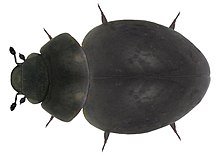Sphaerius
| Sphaerius | |
|---|---|

| |
| Sphaerius acaroides | |
| Scientific classification | |
| Domain: | Eukaryota |
| Kingdom: | Animalia |
| Phylum: | Arthropoda |
| Class: | Insecta |
| Order: | Coleoptera |
| Suborder: | Myxophaga |
| Superfamily: | Sphaeriusoidea |
| Family: | Sphaeriusidae , 1845
Erichson |
| Genus: | Sphaerius Waltl, 1838 |
| Species | |
|
see text | |
| Synonyms | |
| |
Sphaerius is a
The overall form of the beetle is convex, glossy, dark brown or black with some markings possible. The head is prominent, with relatively large eyes set far apart, and
The beetles occur in a variety of damp environments, including mud, under stones, among plant roots and
Females produce a single large egg at a time.
The family used to be known as "Sphaeriidae", but the name was preoccupied by a family of freshwater clams. The name was inappropriately replaced with "Microsporidae" (by changing the genus name to Microsporus), but this act has been superseded by a return to the use of Sphaerius and a reformation of the family name as Sphaeriusidae.[1] The position of the family within Coleoptera has also changed a number of times.[2]
Species
The genus includes the following 18 species, as of 2022:[3]
- Sphaerius acaroides Waltl, 1838 – Europe
- Sphaerius africanus (Endrödy-Younga, 1997) – South Africa
- Sphaerius alticola (Löbl, 1995) – Nepal
- Sphaerius coomani Lesne, 1936 – Vietnam
- Sphaerius gustavlohsei (Löbl, 1995) – Nepal, India: Darjeeling
- Sphaerius hispanicus Matthews, 1899 – France, Spain, Algeria, Tunisia
- Sphaerius humicola (Löbl, 1995) – Nepal
- Sphaerius laeviventris Champion, 1923 – India: Uttarakhand
- Sphaerius madecassus Paulian, 1949 – Madagascar
- Sphaerius obsoletus Lesne, 1936 – Vietnam
- Sphaerius ovensensis (Oke, 1954) – Australia
- Sphaerius perlaevis Lesne, 1936 – Vietnam
- Sphaerius politus Horn, 1868 – USA: California
- Sphaerius silvicola (Löbl, 1995) – Nepal
- Sphaerius spississimus Lesne, 1935 – France: Corsica, Italy: Sardinia, Israel
- Sphaerius tesselatus Lesne, 1936 – Vietnam
- Sphaerius texanus Matthews, 1899 – USA: Texas
- Sphaerius tropicus Matthews, 1888 – Guatemala
Species transferred to Bezesporum:
- Sphaerius minutus Liang & Jia, 2018 – China: Jiangxi
- Sphaerius papulosus Lesne, 1940 – Myanmar
Species of unclear assignment:
- Sphaerius cribratus Lesne, 1936 – Vietnam
- Sphaerius favosus Lesne, 1936 – Vietnam
Species excluded from Sphaeriusidae (actually representatives of Corylophidae):
- "Sphaerius" coenensis Oke, 1954 – Australia
- "Sphaerius" scutellaris(LeConte, 1878) – USA
Fossil Sphaeriusidae
- †Burmasporum Kirejtshuk 2009 Burmese amber, Myanmar, Cenomanian
References
- Ross H. Arnett, Jr. and Michael C. Thomas, American Beetles(CRC Press, 2001)
- S2CID 254440169.
External links
- Sphaeriusidae Tree of Life
